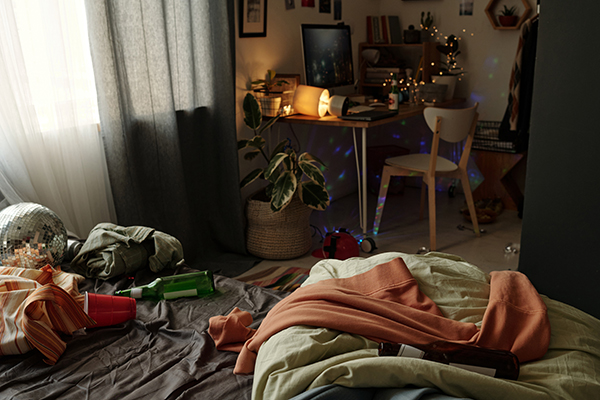
Why “Supervised” Substance Use Isn’t a Smart Parenting Strategy
At the New York Center for Living, parents often ask us whether it is wise to expose adolescents to substances like alcohol in supervised settings. It’s usually framed with care, thoughtfulness, and the best intentions: If my child is going to drink anyway—now or in the future—shouldn’t it be in our home where it’s safe? Isn’t a little exposure better than total abstinence?
This idea—that exposure to alcohol or other substances in a controlled environment will prevent more dangerous behavior later—has become increasingly normalized, particularly in well-resourced communities. Unfortunately, research and experience tell a different story: early, parentally-sanctioned substance use does not protect teens; it increases risk across the board—physically, psychologically, legally, and developmentally.
Early Exposure Increases Risk
Research consistently shows that adolescents who are introduced to alcohol or other substances early are more likely to develop problematic patterns of use later in life. When substance use is normalized during adolescence, especially when seen as an essential element of relaxation or socialization, it tends to reinforce beliefs and behaviors that can escalate into problematic substance use or dependence in young adulthood. What starts as a lesson in moderation can become a blueprint for riskier behavior.
The Social Learning Effect
Young people learn not just through instruction, but through observation. If teens regularly see adults using alcohol or cannabis to manage stress, socialize, or unwind, they begin to internalize those behaviors as normal, desirable, or even healthy. When parents facilitate or participate in this exposure—intentionally or otherwise—it sends a clear message: these substances are tools for coping and connecting. That message is hard to unlearn later, especially when adolescents become young adults and engage in “unsupervised” use both at home and in social situations.
Adolescent Brain Development and Risk
Adolescents are not adults in smaller bodies. The areas of the brain responsible for impulse control, long-term planning, and risk assessment are still developing well into the mid-twenties. Exposing adolescents to substances during this period can interfere with the development of self-regulation and decision-making skills. It also increases the likelihood of immediate harms: overdose or alcohol poisoning, accidents, sexual risk-taking, poor academic outcomes, and mental health struggles.
Supervision Doesn’t Equal Safety
Some parents believe that if a teen drinks under their roof—with their knowledge and oversight—it’s safer than letting them experiment elsewhere. But context matters. Even when “supervised,” substance use tends to occur in peer-driven environments, where social pressures and reduced inhibitions still dominate and often lead to negative consequences. Research suggests that these settings do not reduce harm—they often increase it, especially when boundaries are unclear or inconsistently enforced.
Legal Consequences in New York State
Beyond developmental risks, there are serious legal implications for supervised adolescent substance use. In New York State, it is illegal to serve alcohol to minors, even in one’s own home, unless the alcohol is provided directly by a parent or guardian to their own child. Even then, allowing other underage individuals to consume alcohol in your home can result in criminal charges and civil liability.
Under New York’s Social Host Law, adults can be held responsible if they knowingly allow minors to drink on their property and someone is injured or causes injury as a result. This means parents can face lawsuits and prosecution if a teen drinks at their house and later gets into a car accident, is assaulted, or causes property damage. The intent to supervise does not protect against legal consequences.
A Better Alternative: Structure, Skills, and Connection
The good news is that there are more effective ways to promote healthy autonomy and decision-making. Adolescents benefit from experiences that build self-confidence, coping strategies, and personal agency—structured travel, meaningful responsibilities, creative outlets, and relationships built on open communication. These are the protective factors that help prevent substance misuse—not early exposure.
Speaking of communication, having robust and judgment-free conversations with teens (and younger children) about substances is correlated with healthier habits later in life. While it may seem reasonable that letting children test alcohol will prepare them for more mindful substance use in the future, it is both safer and more effective to engage in consistent communication about substance use while maintaining a boundary that no use is safe during adolescence.
Additionally, parents also have an opportunity to model alternative ways of managing stress, socializing, and celebrating that don’t center on alcohol or substances. When teens see that fun, connection, and calm are possible without a drink in hand, they begin to internalize healthier norms.
The Bottom Line
There’s no one-size-fits-all roadmap for parenting through adolescence. But when it comes to substance use, the evidence is clear: early exposure—especially under the guise of “supervised safety”—is not a protective factor. It’s a risk. A well-intentioned decision today can lead to harm tomorrow, for your child and for you.
At the New York Center for Living, we encourage parents (and teens) to ask themselves hard questions, think critically about the messages they’re sending, and stay curious about healthier paths forward. Raising teens is never easy—but it’s a lot easier when we’re not pretending risky choices are wise just because they’re happening under our watch.
If you have are the parent of an adolescent struggling with substance use issues, or are looking for support or guidance around preventions, please do not hesitate to email us info@centerforliving.org or call us at 212-712-8800.